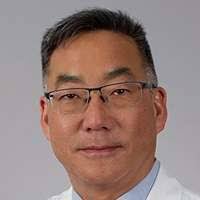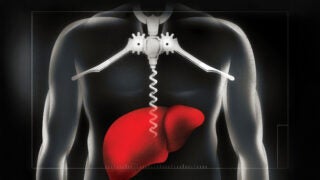When does life end? World Brain Death Project seeks clarity and consensus
When families struggle with the decision to end life support for a loved one, these findings — led by a USC researcher — could provide reassurance.
Before ventilators and CPR came along in the 1950s, declaring death was simple: A person with no heartbeat or respiration was dead. With technology that can restart the heart or keep the heart and lungs going, determination of death moved to the brain — unleashing ethical dilemmas, lawsuits and confusion among doctors and families.
A landmark consensus paper on brain death, published today in JAMA as a “special communication,” aims to guide physicians in determining brain death as well as help families accept its irreversibility. Gene Sung, director of the neurocritical care and stroke division at the Keck School of Medicine of USC, is senior author for the paper and a member of the World Brain Death Project’s steering committee.

“This is one of the most basic parts of being a physician — who’s alive? who’s dead? How does one make these determinations, and how do you tell family members their loved one has died?” said Sung, who also helped oversee the project’s 17 supplementary documents. “That’s why I started this project — we still have some difficulty in dealing with and understanding these problems.”
Sung, who routinely sees patients at LAC+USC Medical Center with catastrophic brain injuries due to stroke and accidents, is an internationally known expert in the subject of brain death. He became interested in the topic through a mentor during his training. He says the goal of the World Brain Death Project is to harmonize practices and improve the rigor of brain death determination — and minimize errors — across the world.
Brain death project factors in religious perceptions and family recommendations
The document — endorsed by almost 30 of the most important medical societies in the world in intensive care, neurology and neurosurgery — includes extensive flow charts, checklists and decision trees, as well as discussions of how world religions perceive brain death and recommendations for supporting families. His hope is that more uniform understanding among doctors will lead to more trust and acceptance from the public.
Today, there’s widespread agreement, especially in the Western world, that human death occurs with brain death — the complete, irreversible stopping of all neurological activity in the brain and brain stem. Doctors perform a number of tests to determine whether someone is brain dead, including one that checks whether the individual can independently take a breath, a primitive reflex carried out by the brain stem.
This is one of the most basic parts of being a physician — who’s alive? who’s dead?
Gene Sung
Brain death is distinct from a coma or a persistent vegetative state. Comatose patients can have brain stem responses, spontaneous breathing or non-purposeful motor responses. Patients in vegetative states are alive but have severely impaired consciousness and cognitive status, although their eyes may open spontaneously.
Brain death is generally accepted in most faiths. In 2000, Pope John Paul II pronounced that organ donation from a brain-dead person was fully consistent with Roman Catholicism. In Judaism, brain death is generally accepted as death by Reform and Conservative rabbis; in Orthodox Judaism, some rabbis require circulation and respiration to cease in order to declare death. Within Islam, Shiites generally accept neurological criteria for death whereas there is disagreement among Sunnis.
But some scholars claim that brain death is merely a “legal fiction” contrived by doctors and
society to permit organ donation. Others cite the fact that some persons diagnosed as brain dead can have their bodies physiologically maintained for months or years, and in some cases, can grow, reach puberty or gestate infants — all capacities, they say, are incompatible with being dead.
Extensive research into brain activity may minimize uncertainty
Physicians face their biggest challenges in declaring brain death when a family rejects the pronouncement. That was the case in a highly publicized lawsuit in which Jahi McMath, a 13-year-old girl from Oakland, Calif., was declared dead through brain death following complications from a surgery in 2013. Her parents considered mechanical ventilation and other measures supporting her vital functions to be life support; her doctors considered this to be futile treatment of a deceased person. Nearly five years later, supportive measures were discontinued due to bleeding caused by liver failure.
The document urges doctors to account for conditions or treatments that can be misleading in determining brain death. For example, extreme cooling — sometimes used on patients with brain injuries or after cardiac arrest — can lead to what looks like a cessation of brain activity. Certain drugs may temporarily suppress breath. Reversible mimics of brain death may be caused by Guillain-Barre? syndrome or even snake bites.
Sung and his colleagues acknowledge that there are gaps in our knowledge and important research remains. For example, has some level of brain activity ever returned to someone declared legally brain dead? (The family of Jahi McMath said she could respond to some verbal commands in the years following her declared death, contrary to multiple expert exams.) Do any people who meet the minimum criteria for brain death have some level of blood flow in the brain? Are there tests that can confirm complete and irreversible destruction of the brain stem?
“This is an important, complex subject. Reaching this kind of consensus across so many organizations is a first,” Sung said. “With this paper and its 17 supplements — virtually a textbook — it’s a foundation that we hope will minimize diagnostic errors and build trust.”
In addition to Sung, other authors of the special communication are David Greer of Boston University School of Medicine and Sam Shemie of McGill University, Montreal Children’s Hospital, who along with Sung contributed equally to the project; Ariane Lewis of NYU Langone Medical Center; Sylvia Torrance of Canadian Blood Services; Panayiotis Varelas of Albany Medical College; Fernando D. Goldenberg of University of Chicago; James L. Bernat of Geisel School of Medicine at Dartmouth; Michael Souter of University of Washington; Mehmet Akif Topcuoglu of Hacettepe University, Ankara, Turkey; Anne W. Alexandrov of University of Tennessee Health Science Center; Marie Baldisseri of University of Pittsburgh Medical Center; Thomas Bleck of Northwestern University Feinberg School of Medicine; Giuseppe Citerio of University Milano-Bicocca, Italy; Rosanne Dawson of Canadian Blood Services; Arnold Hoppe of Universidad del Desarrollo, Santiago, Chile; Stephen Jacobe of University of Sydney and Children’s Hospital of Westmead, Australia; Alex Manara of Southmead Hospital, Bristol, United Kingdom; and Thomas A. Nakagawa of University of Florida.
Additional authors are Thaddeus Mason Pope of Mitchell Hamline School of Law, Saint Paul, Minnesota; William Silvester of University of Melbourne, Australia; David Thomson of University of Cape Town, South Africa; Hussain Al Rahma of Dubai Hospital, United Arab Emirates; Rafael Badenes of University of Valencia, Spain; Andrew J. Baker of University of Toronto; Vladimir Cerny of J.E. Purkinje University, Czech Republic; Cherylee Chang of Queen’s Medical Center, Honolulu; Tiffany R. Chang of University of Texas Health Science Center at Houston; Elena Gnedovskaya and Michael Piradov of Research Center of Neurology, Moscow; Moon-Ku Han of Seoul National University Bundang Hospital; Stephen Honeybul of Sir Charles Gairdner Hospital, Australia; Edgar Jimenez of Texas A&M University; Yasuhiro Kuroda of Kagawa University, Japan; Gang Liu and Ying-Ying Su of Capital Medical University, Beijing; Uzzwal Kumar Mallick of National Institute of Neurosciences and Hospital, Bangladesh; Victoria Marquevich of Hospital Universitario Austral, Buenos Aires; Jorge Mejia-Mantilla of Fundacio?n Valle del Lili, Cali, Colombia; Sarah Quayyum of University of Toronto; Gentle Sunder Shrestha of Tribhuvan University Teaching Hospital, Kathmandu, Nepal; Shelly D. Timmons of Indiana University; Jeanne Teitelbaum of Montreal Neurological Institute; Walter Videtta of National Hospital, Alejandro Posadas, Buenos Aires; and Kapil Zirpe of Ruby Hall Clinic, Pune, India.



